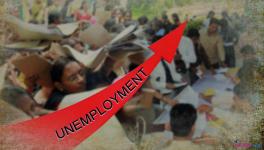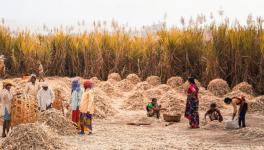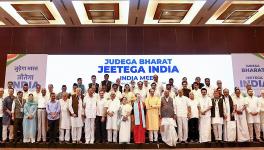Govt Blind to Plight of Rural Labour, Even as Real Wages Fall
Image Courtesy:pixahive
In the recently presented Economic Survey for 2022-23, tucked away in the verbiage and data, there is a nugget of information that should shock the conscience of all Indians, whether ruling BJP supporters or not. According to the calculations done by the government’s own economists, real wages – that is, wages adjusted to inflation – of rural labourers are either stagnating or showing a marginal fall over the past over two years. An earlier survey had noted that there are about 36.5 crore workers in rural India, out of which some 61.5% are employed in agriculture, 20% in industry and 18.5% in services.
These are huge numbers, running into several crores. If one includes their families then the numbers will triple or quadruple. With such a massive section of population facing falling (or stagnant) wages, which are in any case meagre, there is no surprise that the Indian economy is not experiencing any demand, leading to perpetual inertia – and pernicious poverty.
Agri-Labour Worst Hit
Among the agricultural workforce, there are cultivators (or farmers) who may own land in marginal to big holdings. And then there are the landless labourers whose number was estimated at about 14 crore in the last Census completed 11 years ago. Going by past trends, this number would have increased by now.
These numbers are often augmented by lakhs of marginal and small farmers who are forced to take up labour work in others’ fields because their own small holdings are not giving sufficient returns. Work is seasonal and often permeated with social oppression as most of these labourers belong to Scheduled Castes or Tribes, or Other Backward Classes.
But only looking at the most direct economic equation, their wages are pitiably small, as shown in the chart below. For men, the daily wage rate was Rs.364 while for women it was Rs.271 in October 2022. That’s about Rs.11,000 per month for men and about Rs.8,000 for women. Compared with May 2020, these wage rates would appear to show an increase of about 17% for men and 12% for women. But this increase is illusory.
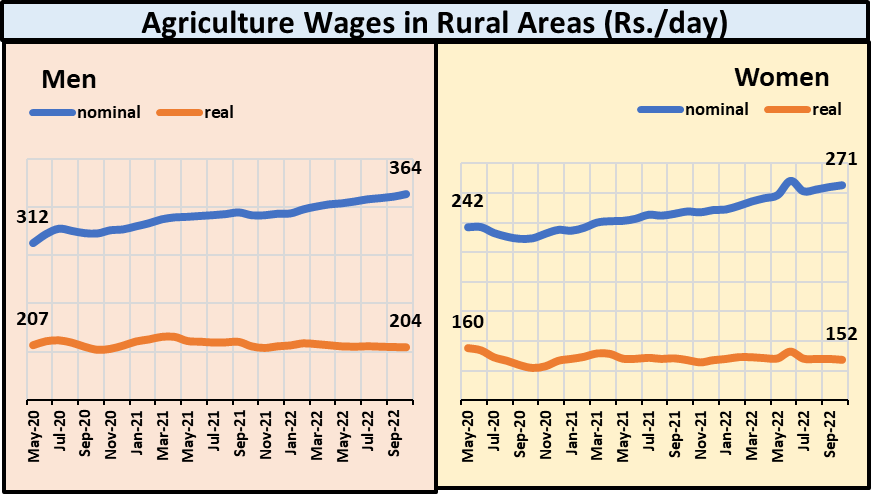
As the orange lines show (in the graph), real wages which are calculated by deducting the price rise in that period, have in fact fallen. For men, real wages fell marginally from Rs.207 to Rs.204 per day while for women, the fall was from Rs.160 to Rs.152 per day.
Remember that these earnings are seasonal – only during certain times of the year is work available in the fields. In all, perhaps 3-4 months’ worth of work can be done in a year by an agricultural labourer. So, at other times, they have to look for non-farm work.
Non-Farm Work is Equally Low Paying
Non-farm work can span a bewildering range of occupations with one individual taking up 3-4 of these simultaneously on a part-time basis. One unpublished survey done by a trade union in Andhra Pradesh found 61 types of work in one village only. Some of the more common works include construction, retail trade, repair jobs, menial labour, domestic work, etc.
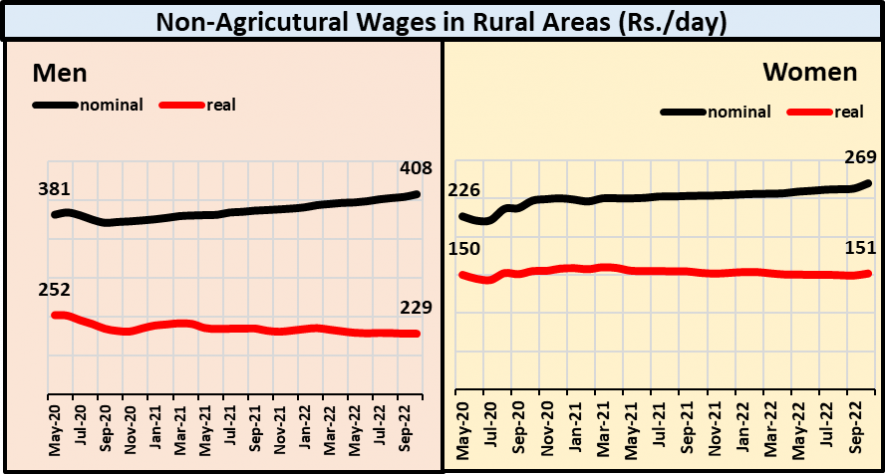
As the chart above shows, nominal wages for men increased from Rs.381 to Rs.408 per day between May 2020 and October 2022. For women, daily wage rates increased from Rs.226 to Rs.269 per day over the same period.
After adjusting for price rise, the picture becomes dire. For men, the daily wage rate fell from Rs.252 to Rs.229 while for women it increased negligibly from Rs.150 to Rs.151.
So, the great boon that non-farm work was supposed to bring to the millions that are thronging agricultural work has evidently failed to deliver. Either way, the labourer in rural areas is destined to suffer from grinding poverty because income is barely sufficient to keep their family alive.
Govt Policies Aggravating Situation
Withdrawal or cutbacks in welfare programmes, such as free healthcare or free education, and nutrition, mean that these families have to neglect these basic needs for their families because the earnings are just not enough to pay for private doctors or schools. In case there is a serious sickness in the family – as must have happened during these pandemic years that the survey was covering – the family has to undertake catastrophic spending after borrowing from relatives, friends or usurious money lenders. Small wonder that the last survey of agricultural households done by the National Statistical Office (NSO) under the Ministry of Statistics, found that just over 50% of agricultural households were indebted.
The rural job guarantee scheme (MGNREGS) provides a lifeline to these labourers, and indeed to others too. According to latest available data, 8.19 crore individuals had already worked under the scheme till date. This is lower than the peaks touched during the pandemic when most of the economy was shut down or restricted. But this year’s numbers are higher than the last pre-pandemic year of 2019-20, which saw 7.88 crore persons working. Clearly, demand for work is high as landless labourers and small and marginal farmers as well as other rural labour keep turning to this scheme to supplement their income.
Raging unemployment is not helping either. But look at the wages offered in MGNREGS: in the current year, average daily wage rate is about Rs.218, last year it was Rs.209, the year before that, Rs.Rs.201. Adjusted to inflation, the wage rate for the current year would be about Rs.122 per day! That’s more than Rs.100 less than the real wage for non-farm work in October 2022. Despite these onerous wages, kept low under pressure from the big landowners, crores are taking up the work just to survive, especially during off-season periods.
No Law for Minimum Wages
It is tragic that in this Amrit Kaal, when 75 years of Independence are being celebrated, there is still no comprehensive law to regulate and determine working conditions, including wages of agricultural workers. This has been a constant demand of various agricultural workers’ unions for years but successive governments have paid no heed.
The current government, which is grappling with a slowing economy and an economic crisis, could kickstart the economy by transferring resources into the hands of the poorest people. This would inject much needed demand in the economy and that, in turn, would spur investment in productive capacities, growth in jobs and overall economic growth.
But this is anathema for the present dispensation, wedded as it is to ‘fiscal prudence’ and the chimerical role of free market and ‘trickle down’ in boosting the economy – an idea that has been discredited by experience, time and again, across the world.
Get the latest reports & analysis with people's perspective on Protests, movements & deep analytical videos, discussions of the current affairs in your Telegram app. Subscribe to NewsClick's Telegram channel & get Real-Time updates on stories, as they get published on our website.














